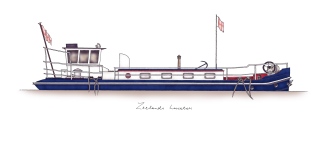This is the story of how an almost 100 year old Dutch barge has been turned into a home in London over the past two years.
I bought Zeelands Luister in the summer of 2013 as a place to stay when I’m working in London. She’s moored on Greenland Dock in Rotherhithe.
She’s a Katwijker Dutch barge, built in 1923. During her lifetime she’s been used for freight, fishing, and latterly as a houseboat.
The previous owners spent a great deal of time and energy working on the hull, engine and on-board systems.
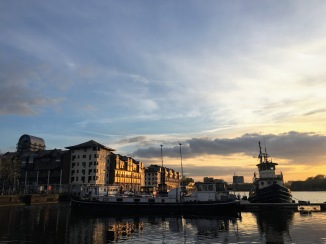
Houseboat life
In 2016 I got serious about turning the houseboat into home. The renovation project was driven in a large part by my fiancé Sarah.
Greenland Dock is an old whaling dock on the south side of the River Thames, opposite Canary Wharf. It sits next to South Dock Marina behind a lock gate off the river. It’s owned and maintained by Southwark Council.
It’s a community of around 50 houseboats. There’s a slower, gentler pace of life than you’d expect given the central London location. It’s an incredible place to live.
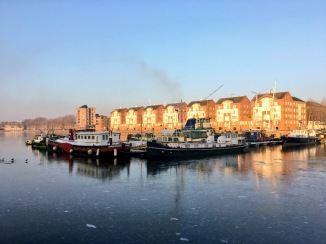
There’s a misconception that houseboat living is low cost. It’s not the case on a London marina. There’s insurance, mooring fees, service costs just like any other property, and constant maintenance.
The alternative lower cost houseboat lifestyle of continuous mooring on the waterways means you have to live off grid and move your boat every couple of weeks.
Every seven years, steel boats such as Zeelands Luister need to be taken out of the water to be inspected by a surveyor and have any maintenance work undertaken. It’s an insurance requirement but it is also good practice.
Project planning
Zeelands Luister is 22 metres long, more than 4 metres wide, and weighs approximately 30 tonnes.
She’s too heavy to be lifted out of the water by any of the cranes along the River Thames in London, and so after extensive research we booked her into Turk’s Yard at the Historic Dockyard in Chatham for a three week slot in May.
Work started in earnest the previous summer to service the engine and electrical systems, ready for the trip.
Alex Stele a marine engineer that lives on the marina managed the work.
An engine and gearbox manual were sourced from the internet. Parts for the Detroit engine were sourced and couriered from around the world.
Alex overhauled the engine and the Lister engine in the anchor winch at the front of the boat.
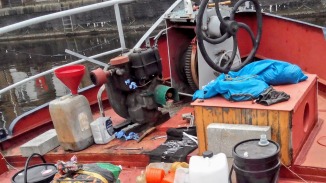
A key principle for the project has been to strip back the boat insofar as possible to its original design. All electrical and mechanical systems were simplified.
Every owner has made their mark on the houseboat. The quality of skills involved have been mixed.
Redundant features were removed. Old pipework, chimneys, cabling and radiators have been cut, ground and removed.
The engine room, wheel house and rear hold had become home to decades of junk, including old cans of paint, cables, ropes, chains, and assorted storage.
Trollies of scrap were carted along the pontoons and carted to a recycling centre on the Old Kent Road, near Elephant and Castle.
Ship to shore
There’s a huge amount of anxiety associated with taking a boat out of the water in a dry dock. It’s an unnatural state for a boat and you’re never quite sure what you’ll find.
As a minimum we wanted to ensure the integrity of the hull.
There was then a long list of activities, budget allowing, including a new door frame, capping pipework, deck repairs, the removal and replacement of rotten gunnels, likewise railings, addition of grab rails, and a new chimney on the engine room.
Sandblasting and painting completed the wish list.
A characteristic of river life is that you must have a deep respect for its energy. You have to work with the tides.
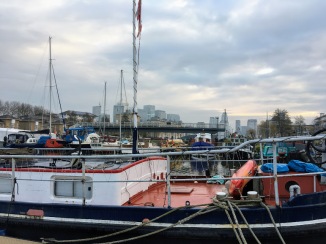
Adrian Priestman, another Greenland resident, skippered the boat out to Chatham.
It meant leaving at dawn on a high tide, and following the course of the river to the Medway, before mooring up alongside an old freight barge and waiting for the tide to carry us into Chatham.
Alex would join us for the trip to maintain the engine, along with one of my daughters, Freya, and my son, Dan.
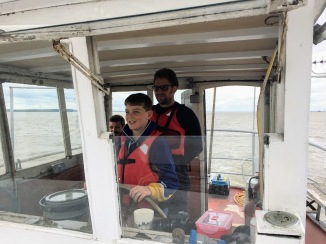
We moved the boat on the eve of the trip from Greenland Dock through the road bridge on Rope Street into South Dock, and onto a temporary mooring next to the lock gate.
This manoeuvre enabled us to get into the lock as soon as the tide turned in the morning.
Alex and Adrian are smart, canny people. Their confidence and ease is infectious. What could have been a daunting trip became a huge adventure.
The journey up river was incredible. We took in the sights of London: Greenwich, the O2 and the Thames Barrier.
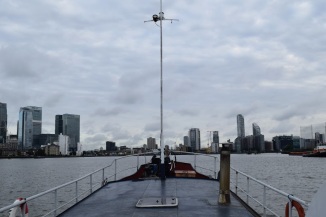
Next came the Dartford River Crossing and heavy industry before we headed into the Thames estuary.
Here the river becomes so wide that you may as well be at sea. We all had a go at steering the boat under Adrian’s watch.
We navigated around the SS Richard Montgomery exclusion zone. The ship was wrecked on sandbank near Sheerness in 1944. Around 1,400 tonnes of explosives remain on board.
Dockyard works
Manoeuvring a boat into a dry dock is a serious exercise. We were met by the dockyard crew, well practiced in the task.
We moved into position outside the dock at high tide and edged our way through the open sluice gates in the dock.
The boat was moved into place on to a bogey using ropes. It was towed up the dockyard ramp, to reveal itself out of the water for the first time.
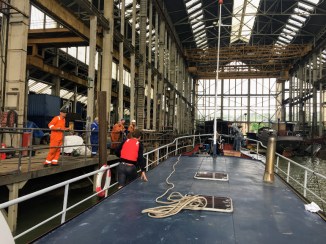
It was an incredible conclusion to a long day. Out of the water, the boat took on new proportions. The propeller itself was the size of a child.
The initial week that Zeelands Luister was in the dock was an anti-climax. Work couldn’t start until the boat was jet sprayed and surveyed. We then had to agree a schedule, work plan, and critically a budget.
More than a tonne of shellfish was washed off the hull.
Adrian returned to survey the hull. He’s a man of many talents: skipper, marine surveyor, architect and maker.
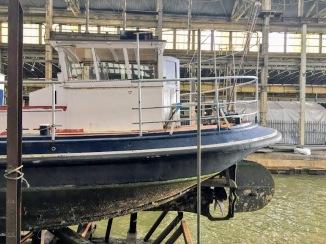
The steel was in good shape however he recommended modifications to the main water tank in the rear hold and the addition of a bilge pump in the main living area.
We also needed to replace the anodes. These are sacrificial pieces of metal fixed to the propeller and hull.
The next job was a negotiation with yard owner Richard Turk.
We agreed to undertake all the works planned, and as a result, extend the time that the boat would spend in the yard to five weeks.
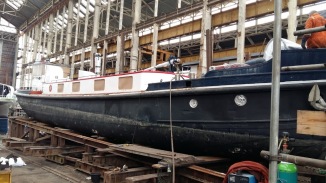
It was a tough month. I was working in London without a place to stay, and travelling back and forth from home to Newcastle.
In bid to save cost I stayed in a variety of Airbnb accommodation in East London, booked on a week to week basis. Most were rooms in shared houses.
I’m not tight but I am careful with cash, however I wouldn’t recommend this lifestyle to anyone.
Each week I made the trip on a Tuesday or Wednesday evening to Chatham to check on the progress of the works.
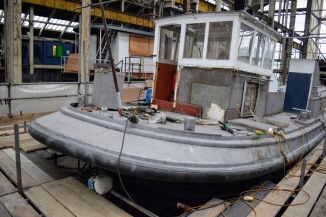
Sarah and I spent a further weekend in the dockyard taking photographs and deciding on a new colour scheme.
The entire surface of the boat was sandblasted back to the metal. Paint and rust gave way to undiscovered areas of rot, adding to the list of steelwork.
The rebuild took around three weeks.
The rotten gunnels and railing were removed, and new steelwork fabricated.
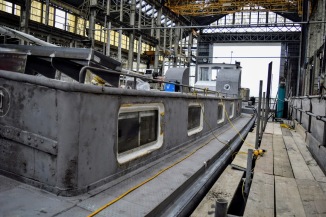
The front door was removed and a new one welded in its place. Areas of the wheelhouse were replaced.
Sections on the front of the boat that had been corroded by the passage of time were cut out and replaced.
A massive bracket was fabricated and welded to the rear bulkhead for the water tank and the old free standing structure removed.
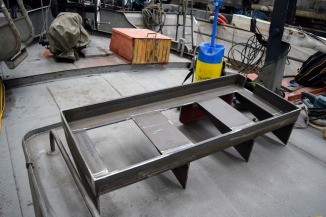
Areas of the deck were over plated. Bollards were replaced.
Welding is filthy work but incredibly skilled. It was amazing to watch the work in progress, and see the vision of returning the boat to its original shape fulfilled.
In the final two weeks in the yard the boat was painted. This in itself was a revelation. The surface of the boat had become pitted with layer after layer of paint.
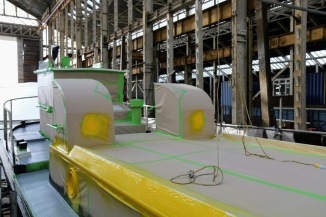
We reckon that sandblasting removed around 17 layers of paint. The respray was transformational.
Reversing the route and heading home
Sarah made the return trip to London with Adrian and Alex in late-June. They set off around midday on a high tide, arriving back at Greenland Dock around 10pm.
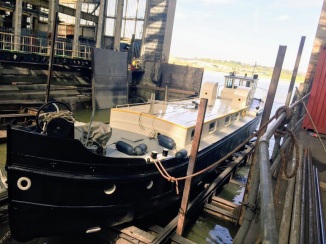
Zeelands Luister made the trip back into South Dock around midnight and moored up for the night in South Dock.
We made the trip back into Greenland Dock the following morning, welcomed home by neighbours. The arrival or departure of a boat in South Dock or Greenland Dock is always a moment of celebration.
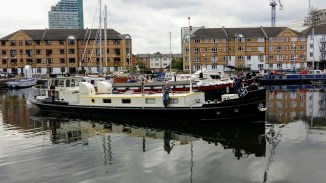
Zeeland Luister’s arrival back onto its mooring was the start of an overhaul of the internal decor. Here Sarah’s firmly taken the lead. She’s a vision and bravery that I lack.
The first job was a deep clean. Next I finished all the odd woodwork jobs that I’d left neglected, and prepped for painting.
Internal works
We’ve been fortunate to work with some incredible craftspeople.
Dave Smith from Whitley Bay spent a week on the boat, painting the interior and the wheelhouse.
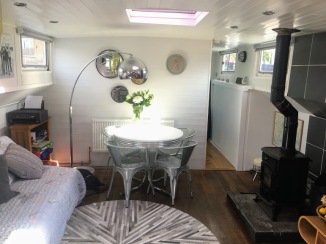
I wouldn’t ever have been brave enough to paint the entire inside of the boat white, and I resisted for a long time, but Dave undertook the work at Sarah’s insistence. The effect on the light and space inside the boat has been transformational.
Lee Baker has repaired and repainted the kitchen, and replaced the hardware on doors and cupboards. I highly recommend it as a cost effective way of modernising your kitchen however the drive back and forth to Lee’s workshop in Newcastle was perhaps extreme.
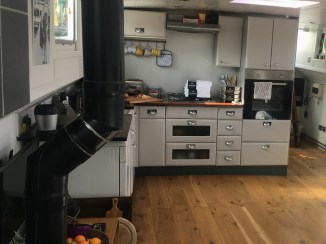
Chris Olley replaced the roof on the wheelhouse. He has also repaired the front door and plinths in the kitchen.
We’ve found some brilliant makers thanks to the internet.
New blinds have been made to match the decor by Melanie Smith and her team at Affordable Blinds Direct in Margate, Kent. Richard Holdsworth who runs a design company in Bradford has made porthole covers for the front cabin.
We’ve stripped back the fittings and furniture to a minimum but invested in quality. You have to be careful with what you add to a houseboat because space is so minimal.
Our one huge extravagance has been a hot tub on the top deck of the boat. It overlooks Canary Wharf and makes us smile every time we take a dip. It’s a reminder of how lucky we are to live in such an incredible space.
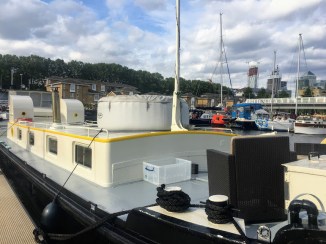
The old bed has gone replaced with a minimal design from Made. We’ve commissioned black and white prints of family.
Circles have become a feature of the internal decor.
Sarah spotted a local restaurant near home on Facebook that was selling tables as part of a refit. Decorum in Shoreditch has supplied mirrors, a concrete clock and coffee table.
Cabinet maker Dan Cluett has made fitted drawers and a cupboard. He’s also added sliding doors to an existing cupboard. The impact has been transformation.
We’ve overhauled the wheelhouse. It doubles up as as a bedroom and an office. Miryam Brizuela at Marine Canvas Hut designed and fabricated window blinds.
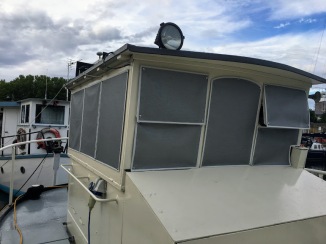
I’m keen to investigate home automation technology. The diesel central heating is already controlled via an app but we’ve bought an Amazon Alexa and are keen to explore lighting, heating and home security.
There’s still work to do but then there always will. I’m keen to continue to invest in modernising the internal systems.
Creating a legacy
I fell in love with Zeelands Luister the first time I saw the boat. Houseboats aren’t a rational purchase. I spent three years living aboard but she was never a home. That changed last summer.
The work we’ve completed means that the boat will outlive everyone that has been part of her story. Zeelands Luister is an incredible legacy.
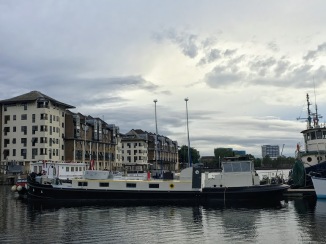
Recommendations
We’re incredibly grateful to everyone that has been part of the project. We wholly recommend the services of everyone listed below.
Alex Stele
Marine Engineer
07876 564284
Adrian Priestman
Architect, designer and maker
Priestman Marine Surveys
07957 420325
Richard Turk
Turks Shipyard
07815 740252
Dave Smith
Dave Smith Decorator
07968 854451
Lee Baker
Hand painted kitchens
07786 520233
Chris Olley
Carpenter
07837 510538
Melanie Smith
Affordable Blinds Direct
01843 229596
Richard Holdsworth
Porthole Covers
07976 556805
Dan Cluett
Cluett Carpentry
07527 827514
Miryam Brizuela
Marine Canvas Hut
0759 4516177
Thanks also to the team at South Dock Marina, in particular Patrick Keating and Mark Jackson.

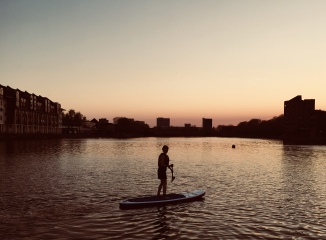
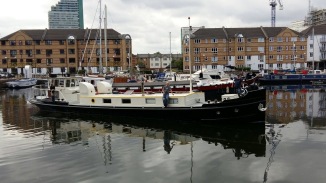
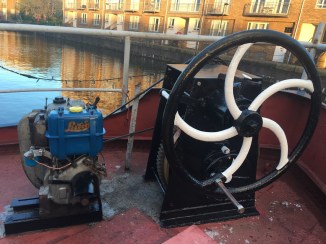
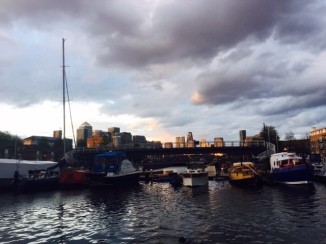
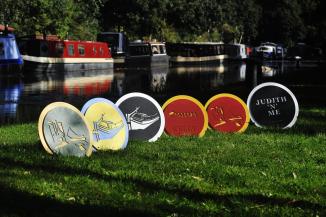
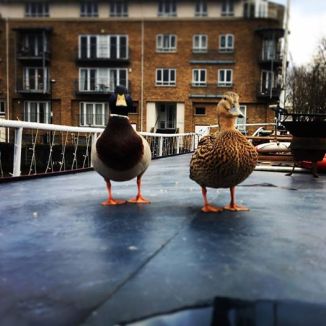
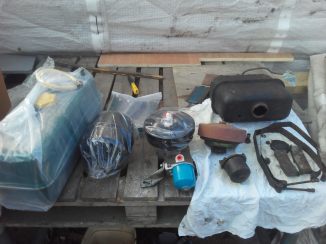 New parts for the anchor windlass engine. It’s located at the front of the boat in the stern and lifts the anchor. The engine is having a complete overhaul and we’re replacing filters and the petrol tank
New parts for the anchor windlass engine. It’s located at the front of the boat in the stern and lifts the anchor. The engine is having a complete overhaul and we’re replacing filters and the petrol tank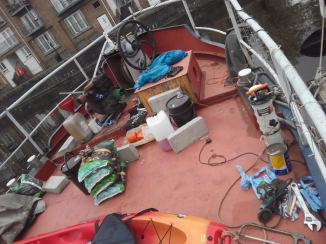 An intensive programme of work is underway to restore the anchor and windlass. It’s stiff after not being used for at least five years.
An intensive programme of work is underway to restore the anchor and windlass. It’s stiff after not being used for at least five years.